Quilting Part 1 Quilting Part 2 Quilting Part 3 Qulting Part 4
A Traditional Doukhobor Quilt
The traditional wool filled quilt was brought to Canada from the mountainous Caucasus region of Georgia by the Doukhobor spiritual ancestors when they were exiled from Russia for their religious beliefs in the late 1800s. While the Doukhobors lived in the Caucasus, the Russian authorities believed the people would not survive the harsh barren, severe weather conditions. But these strong willed people proved them wrong. Deep within the mountainous areas, they raised sheep and cattle, grains and vegetables which helped them survive. At that time, herds of sheep were raised for food and fibre and the fleece was sheared, washed, carded and spun to produce clothing and bedding.
In 1999, the Friends in Unity Ladies Choir travelled to Russia and Georgia, where they reunited with the descendants of the Doukhobors who chose not to immigrate to Canada. To this day sheep continue to be part of their culture. Fleece continues to be prepared for yarn and quilts. Most choir members experienced sleeping in cold, unheated homes in September cuddled under the warmth of hand quilted wool blankets and laying upon quilted wool mattress pads. Some of the group returned from the trip with gifts of hand knitted socks.
Most Doukhobor families in Canada treasure these quilts and continue to prepare special wedding blankets for both the bride and groom. This is usually done by the parents of the bridal couple, where in the past; mothers of the bride and groom, and close family members did the quilting. The quilting of these blankets has slowly become a lost art and now most families try to find a quilter in the community to do the task. Styles, sizes and materials used to make these blankets vary. Some prefer to use polyester fibre fill rather than wool, but the method of quilting remains the same.
Preparation of the Fleece
After the Doukhobors moved to B.C. from Saskatchewan in the 1930’s, very few B.C. Doukhobors raised sheep, but traded fruit or lumber, items that were available in B.C. for fleece with remaining relatives in the Prairie Provinces. The fleece arrived in B.C. shipped in burlap sacks, freshly sheared, unsorted and unwashed.
Many families stocked fleece for future use and the chore of cleaning the fibre took time and talent. As it was sorted, debris was removed and it was washed with care so that the wool would not mat during the whole process. Water was heated in the bath house or out doors, usually in the summer months. Large galvanized tubs, with wooden paddles were used. Pre-sorted fleece was soaked in cold water, and then transferred to tubs of warm water with dissolved laundry soap. Another method was when water was heated in large 45 gallon metal barrels, over an open fire, near a creek or river. Women, individually or in groups would wash the fleece in several changes of water, and then walk into a creek or river with clumps of the washed fleece, allowing the current to run through it to help remove further particles. After the rinsing was completed, it was spread out on clean sheets or hung over the fences or rope clothes lines to allow a summer breeze to complete the drying process. It was then given a good shaking to remove any remaining dirt particles before storing in clean cotton sacks. This was a task done many times by the children in villages who considered it to be a “fun” chore.
The washed wool was stored in a clean, dry place ready for carding and spinning which was usually done in the winter months. During the winter there was more time for the women to do their spinning, weaving, quilting and knitting. The process of washing and carding the wool is now often done commercially. The Cultural Interpretive Society transports wool, which is donated by community members, to Custom Woolen Mills Ltd. in Carstairs, Alberta for cleaning and carding.



